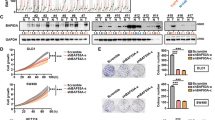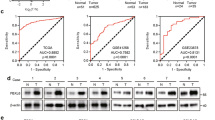Abstract
Colorectal cancers with mutations in the p53 gene have an invasive property, but its underlying mechanism is not fully understood. Through the screening of two data sets of the genome-wide expression profile, one for p53-introduced cells and the other for the numbers of cancer tissues, we report here X-linked ectodermal dysplasia receptor (XEDAR), a member of the TNFR superfamily, as a novel p53 target that has a crucial role in colorectal carcinogenesis. p53 upregulated XEDAR expression through two p53-binding sites within intron 1 of the XEDAR gene. We also found a significant correlation between decreased XEDAR expressions and p53 gene mutations in breast and lung cancer cell lines (P=0.0043 and P=0.0122, respectively). Furthermore, promoter hypermethylation of the XEDAR gene was detected in 20 of 20 colorectal cancer cell lines (100%) and in 6 of 12 colorectal cancer tissues (50%), respectively. Thus, the XEDAR expression was suppressed to <25% of surrounding normal tissues in 12 of 18 colorectal cancer tissues (66.7%) due to either its epigenetic alterations and/or p53 mutations. We also found that XEDAR interacted with and subsequently caused the accumulation of FAS protein, another member of p53-inducible TNFR. Moreover, XEDAR negatively regulated FAK, a central component of focal adhesion. As a result, inactivation of XEDAR resulted in the enhancement of cell adhesion and spreading, as well as resistance to p53-induced apoptosis. Taken together, our findings showed that XEDAR is a putative tumor suppressor that could prevent malignant transformation and tumor progression by regulating apoptosis and anoikis.
This is a preview of subscription content, access via your institution
Access options
Subscribe to this journal
Receive 50 print issues and online access
$259.00 per year
only $5.18 per issue
Buy this article
- Purchase on Springer Link
- Instant access to full article PDF
Prices may be subject to local taxes which are calculated during checkout





Similar content being viewed by others
Accession codes
References
Afford SC, Randhawa S, Eliopoulos AG, Hubscher SG, Young LS, Adams DH . (1999). CD40 activation induces apoptosis in cultured human hepatocytes via induction of cell surface fas ligand expression and amplifies fas-mediated hepatocyte death during allograft rejection. J Exp Med 189: 441–446.
Beroud C, Soussi T . (2003). The UMD-p53 database: new mutations and analysis tools. Hum Mutat 21: 176–181.
Diez M, Medrano M, Muguerza JM, Ramos P, Hernandez P, Villeta R et al. (2000). Influence of tumor localization on the prognostic value of P53 protein in colorectal adenocarcinomas. Anticancer Res 20: 3907–3912.
Folkman J, Moscona A . (1978). Role of cell shape in growth control. Nature 273: 345–349.
Furutani M, Arii S, Tanaka H, Mise M, Niwano M, Harada T et al. (1997). Decreased expression and rare somatic mutation of the CIP1/WAF1 gene in human hepatocellular carcinoma. Cancer Lett 111: 191–197.
Golubovskaya VM, Finch R, Kweh F, Massoll NA, Campbell-Thompson M, Wallace MR et al. (2008). p53 regulates FAK expression in human tumor cells. Mol Carcinog 47: 373–382.
Grell M, Zimmermann G, Gottfried E, Chen CM, Grunwald U, Huang DC et al. (1999). Induction of cell death by tumour necrosis factor (TNF) receptor 2, CD40 and CD30: a role for TNF-R1 activation by endogenous membrane-anchored TNF. EMBO J 18: 3034–3043.
Hollstein M, Rice K, Greenblatt MS, Soussi T, Fuchs R, Sorlie T et al. (1994). Database of p53 gene somatic mutations in human tumors and cell lines. Nucleic Acids Res 22: 3551–3555.
Ilic D, Almeida EA, Schlaepfer DD, Dazin P, Aizawa S, Damsky CH . (1998). Extracellular matrix survival signals transduced by focal adhesion kinase suppress p53-mediated apoptosis. J Cell Biol 143: 547–560.
Ilic D, Furuta Y, Kanazawa S, Takeda N, Sobue K, Nakatsuji N et al. (1995). Reduced cell motility and enhanced focal adhesion contact formation in cells from FAK-deficient mice. Nature 377: 539–544.
Kidokoro T, Tanikawa C, Furukawa Y, Katagiri T, Nakamura Y, Matsuda K . (2008). CDC20, a potential cancer therapeutic target, is negatively regulated by p53. Oncogene 27: 1562–1571.
Kitahara O, Furukawa Y, Tanaka T, Kihara C, Ono K, Yanagawa R et al. (2001). Alterations of gene expression during colorectal carcinogenesis revealed by cDNA microarrays after laser-capture microdissection of tumor tissues and normal epithelia. Cancer Res 61: 3544–3549.
Lark AL, Livasy CA, Calvo B, Caskey L, Moore DT, Yang X et al. (2003). Overexpression of focal adhesion kinase in primary colorectal carcinomas and colorectal liver metastases: immunohistochemistry and real-time PCR analyses. Clin Cancer Res 9: 215–222.
Lee SH, Shin MS, Kim HS, Lee HK, Park WS, Kim SY et al. (1999). Alterations of the DR5/TRAIL receptor 2 gene in non-small cell lung cancers. Cancer Res 59: 5683–5686.
Levine AJ . (1997). p53, the cellular gatekeeper for growth and division. Cell 88: 323–331.
Liang F, Liang J, Wang WQ, Sun JP, Udho E, Zhang ZY . (2007). PRL3 promotes cell invasion and proliferation by down-regulation of Csk leading to Src activation. J Biol Chem 282: 5413–5419.
Liu X, Yue P, Khuri FR, Sun SY . (2005). Decoy receptor 2 (DcR2) is a p53 target gene and regulates chemosensitivity. Cancer Res 65: 9169–9175.
Matsuda K, Yoshida K, Taya Y, Nakamura K, Nakamura Y, Arakawa H . (2002). p53AIP1 regulates the mitochondrial apoptotic pathway. Cancer Res 62: 2883–2889.
McLean GW, Carragher NO, Avizienyte E, Evans J, Brunton VG, Frame MC . (2005). The role of focal-adhesion kinase in cancer—a new therapeutic opportunity. Nat Rev Cancer 5: 505–515.
Mori T, Anazawa Y, Iiizumi M, Fukuda S, Nakamura Y, Arakawa H . (2002). Identification of the interferon regulatory factor 5 gene (IRF-5) as a direct target for p53. Oncogene 21: 2914–2918.
Naito A, Yoshida H, Nishioka E, Satoh M, Azuma S, Yamamoto T et al. (2002). TRAF6-deficient mice display hypohidrotic ectodermal dysplasia. Proc Natl Acad Sci USA 99: 8766–8771.
Nakamura Y . (2004). Isolation of p53-target genes and their functional analysis. Cancer Sci 95: 7–11.
Newton K, French DM, Yan M, Frantz GD, Dixit VM . (2004). Myodegeneration in EDA-A2 transgenic mice is prevented by XEDAR deficiency. Mol Cell Biol 24: 1608–1613.
Nikiforov MA, Hagen K, Ossovskaya VS, Connor TM, Lowe SW, Deichman GI et al. (1996). p53 modulation of anchorage independent growth and experimental metastasis. Oncogene 13: 1709–1719.
Oda K, Arakawa H, Tanaka T, Matsuda K, Tanikawa C, Mori T et al. (2000). p53AIP1, a potential mediator of p53-dependent apoptosis, and its regulation by Ser-46-phosphorylated p53. Cell 102: 849–862.
Owens LV, Xu L, Craven RJ, Dent GA, Weiner TM, Kornberg L et al. (1995). Overexpression of the focal adhesion kinase (p125FAK) in invasive human tumors. Cancer Res 55: 2752–2755.
Pharoah PD, Day NE, Caldas C . (1999). Somatic mutations in the p53 gene and prognosis in breast cancer: a meta-analysis. Br J Cancer 80: 1968–1973.
Rampino N, Yamamoto H, Ionov Y, Li Y, Sawai H, Reed JC et al. (1997). Somatic frameshift mutations in the BAX gene in colon cancers of the microsatellite mutator phenotype. Science 275: 967–969.
Sinha SK, Chaudhary PM . (2004). Induction of apoptosis by X-linked ectodermal dysplasia receptor via a caspase 8-dependent mechanism. J Biol Chem 279: 41873–41881.
Sinha SK, Zachariah S, Quinones HI, Shindo M, Chaudhary PM . (2002). Role of TRAF3 and -6 in the activation of the NF-kappa B and JNK pathways by X-linked ectodermal dysplasia receptor. J Biol Chem 277: 44953–44961.
Smahi A, Courtois G, Rabia SH, Doffinger R, Bodemer C, Munnich A et al. (2002). The NF-kappaB signalling pathway in human diseases: from incontinentia pigmenti to ectodermal dysplasias and immune-deficiency syndromes. Hum Mol Genet 11: 2371–2375.
Takakuwa T, Dong Z, Nakatsuka S, Kojya S, Harabuchi Y, Yang WI et al. (2002). Frequent mutations of Fas gene in nasal NK/T cell lymphoma. Oncogene 21: 4702–4705.
Tanaka H, Arakawa H, Yamaguchi T, Shiraishi K, Fukuda S, Matsui K et al. (2000). A ribonucleotide reductase gene involved in a p53-dependent cell-cycle checkpoint for DNA damage. Nature 404: 42–49.
Tanikawa C, Matsuda K, Fukuda S, Nakamura Y, Arakawa H . (2003). p53RDL1 regulates p53-dependent apoptosis. Nat Cell Biol 5: 216–223.
Vogelstein B, Fearon ER, Kern SE, Hamilton SR, Preisinger AC, Nakamura Y et al. (1989). Allelotype of colorectal carcinomas. Science 244: 207–211.
Vogelstein B, Lane D, Levine AJ . (2000). Surfing the p53 network. Nature 408: 307–310.
Weiner TM, Liu ET, Craven RJ, Cance WG . (1993). Expression of focal adhesion kinase gene and invasive cancer. Lancet 342: 1024–1025.
Wu GS, Burns TF, McDonald III ER, Jiang W, Meng R, Krantz ID et al. (1997). KILLER/DR5 is a DNA damage-inducible p53-regulated death receptor gene. Nat Genet 17: 141–143.
Yan M, Wang LC, Hymowitz SG, Schilbach S, Lee J, Goddard A et al. (2000). Two-amino acid molecular switch in an epithelial morphogen that regulates binding to two distinct receptors. Science 290: 523–527.
Acknowledgements
We thank T Katagiri for helpful discussion and A Takahashi K Makino for her technical assistance. This work was supported partly by grant #18687012 from Japan Society for the Promotion of Science and Ministry of education, culture, sports, science and technology of Japan (to KM). CT is a JSPS Research Fellow.
Author information
Authors and Affiliations
Corresponding author
Additional information
Supplementary Information accompanies the paper on the Oncogene website (http://www.nature.com/onc)
Supplementary information
Rights and permissions
About this article
Cite this article
Tanikawa, C., Furukawa, Y., Yoshida, N. et al. XEDAR as a putative colorectal tumor suppressor that mediates p53-regulated anoikis pathway. Oncogene 28, 3081–3092 (2009). https://doi.org/10.1038/onc.2009.154
Received:
Revised:
Accepted:
Published:
Issue Date:
DOI: https://doi.org/10.1038/onc.2009.154
Keywords
This article is cited by
-
Tissue specificity and spatio-temporal dynamics of the p53 transcriptional program
Cell Death & Differentiation (2023)
-
p53-dependent induction of P2X7 on hematopoietic stem and progenitor cells regulates hematopoietic response to genotoxic stress
Cell Death & Disease (2021)
-
Integrative analysis of multiple types of genomic data using an accelerated failure time frailty model
Computational Statistics (2021)
-
Identification of a p53 target, CD137L, that mediates growth suppression and immune response of osteosarcoma cells
Scientific Reports (2017)
-
Census and evaluation of p53 target genes
Oncogene (2017)



